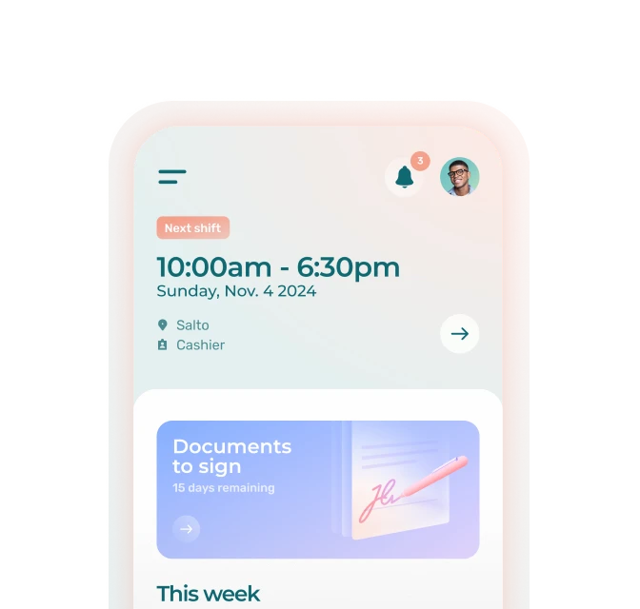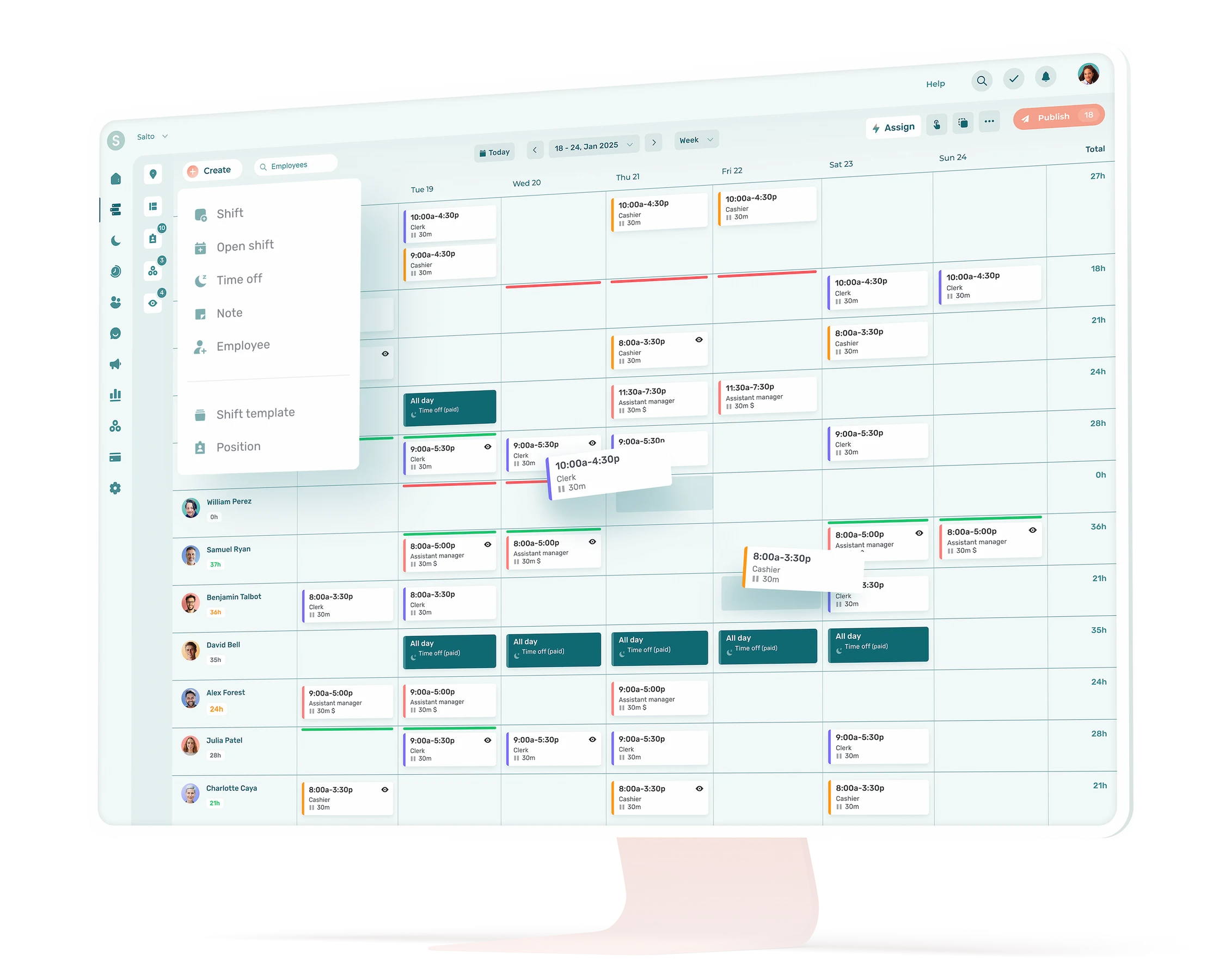The way we work is constantly evolving, and with that comes a variety of work schedule types.
This article offers a deep dive into the most common types of work schedules, including their advantages and disadvantages, which types of businesses they are most suited for, and examples of each type of schedule in action. It also includes best practices for creating an effective work schedule.
What Is a Work Schedule?
A work schedule outlines the days and hours when an employee works and includes shift start and end times, breaks, planned work hours, days off, and vacation time. It can be set by the employer or employee and is crucial for maintaining a consistent work environment and meeting organizational needs.
Why Is Work Scheduling Important?
1. Avoids Disruptions in Workflow or Productivity
Whether your business uses fixed work schedules or flexible work schedules, implementing the right employee scheduling will ensure the right employees are available at the right time to meet the needs of the organization.
2. Ensures Sufficient Coverage
Work scheduling helps to manage staffing levels and ensure that there are enough employees available to handle the workload.
3. Improves Employee Satisfaction and Well-Being
Work scheduling helps to maintain a predictable and consistent work environment for team members, thus having a positive impact on job satisfaction and staff well-being.
4. Reduces Costs
Work scheduling can help to reduce costs by minimizing overtime and ensuring that labor resources are used effectively. Some scheduling software lets you see planned staff vs. sales forecast, keeping your labor costs in check.
15 Most Common Types of Work Schedules
1. Full-Time Schedules
What It Is
A full-time work schedule is typically a fixed schedule consisting of 40 hours per week, with most employees working the same shift five days a week.
Advantages & Disadvantages
Pros: consistent hours and benefits for employees, scheduling shifts is generally easy for managers.
Cons: lack of flexibility.
Who It Is Best Suited For
Businesses with full-time employees who must be available during traditional business hours, such as banks, law firms, offices, and government agencies.
Example
An employee working a full-time schedule may work Monday through Friday from 9 am to 5 pm, with a 1-hour lunch break each day.
2. Part-Time Schedules
What It Is
With a part-time work schedule, employees work typically less than 40 hours per week, often fewer than five days per week. Part time schedules may mean a fixed work schedule or a flexible work schedule. Part time employees may work different shifts, such as morning shifts, split shifts, or night shifts—or a combination of shifts.
Advantages & Disadvantages
Pros: flexibility for employees.
Cons: lack of benefits and inconsistent hours; employees often ask to swap shifts, which can complicate scheduling.
Who It Is Best Suited For
Businesses that have fluctuating workloads and need additional staff during peak times, such as retail stores, restaurants, and delivery services.
Example
An employee working a part time schedule may work 20 hours per week, with shifts on Thursday and Friday from 1 pm to 5 pm and Saturday from 10 am to 6 pm.
3. Shift Schedules
What It Is
Shift work involves working outside of traditional business hours, such as the swing shift. Shift work can be done on a fixed schedule, a flexible work schedule, or a rotating shift schedule. Shift schedules sometimes entail working night shifts. Businesses that operate around the clock often use 24-hour shift schedules to ensure 24/7 coverage. A DuPont shift schedule is a common type of rotating schedule.
Advantages & Disadvantages
Pros: flexibility and potential for working different shift schedules.
Cons: disruptions to sleep schedules and social life.
Who It Is Best Suited For
Businesses that require round-the-clock coverage, such as hospitals, manufacturing plants, and call centers.
Example
An employee working a rotating shift work schedule may work a 12-hour night shift from 7 pm to 7 am for three nights in a row, followed by three nights off.
4. Split Shift
What It Is
With a split shift, the employee works two separate shifts in one day, with a break in between. Split shift work can be done on a fixed schedule or a flexible work schedule.
Advantages & Disadvantages
Pros: flexibility for employees and reduced commute time; a good choice for employees who prefer to work fewer hours consecutively, but still want to work a certain number of hours per week.
Cons: lack of consecutive free time and difficulty maintaining a good work-life balance.
Who It Is Best Suited For
Businesses that require coverage during peak hours, such as restaurants and retail stores.
Example
An employee working a split shift schedule may work from 10 am to 1 pm, take a break from 1 pm to 4 pm, and then return to work from 4 pm to 8 pm.
5. Compressed Work Schedules
What It Is
A compressed work schedule is typically a fixed schedule in which employees work full-time hours in fewer than five days per week, such as four ten-hour days.
Advantages & Disadvantages
Pros: extended weekend and reduced commuting costs.
Cons: long hours and potential for burnout.
Who It Is Best Suited For
Businesses that have flexibility in their work hours and can accommodate longer shifts, such as hospitals, government agencies, and some manufacturing plants.
Example
Employees working compressed work schedules may work four 10-hour shifts from Monday to Thursday, with Friday, Saturday, and Sunday off.
6. Flexible Schedules
What It Is
A flexible work schedule lets employees choose their own work hours, within certain parameters set by the employer.
Advantages & Disadvantages
Pros: flexibility for employees to have a better work life balance and potential for increased productivity.
Cons: difficulty with communication and potential for abuse.
Who It Is Best Suited For
Businesses with knowledge workers who can work independently and don’t require close supervision, such as technology companies, marketing firms, and consulting firms.
Example
An employee working a flexible schedule may choose to work from 7 am to 3 pm or from 10 am to 6 pm, as long as they work a total of 8 hours per day.
7. Job Sharing
What It Is
Job sharing involves two employees splitting the responsibilities of one full-time job.
Advantages & Disadvantages
Pros: flexibility for employees and reduced labor costs for the employer.
Cons: potential for communication difficulties and inconsistent work quality.
Who It Is Best Suited For
Businesses that have positions that can be easily divided and don’t require a lot of interaction between team members, such as non-profits, education, and government agencies.
Example
Two employees may split a full-time job, with one employee working Monday, Wednesday, and Friday, and the other working Tuesday and Thursday.
8. On-Call Schedules
What It Is
With an on-call schedule, employees must be available to work at a moment’s notice, often outside of normal business hours. Some businesses pay employees extra for working on call schedules.
Advantages & Disadvantages
Pros: flexibility and potential for increased pay for the employee.
Cons: disruptions to personal life and uncertainty about work hours.
Who It Is Best Suited For
Businesses that require emergency or on-demand services, such as IT support and maintenance workers.
Example
An employee working an on-call schedule may be required to be available for work at any time outside of their regular work hours, and may receive a call to work with little notice.
9. Seasonal Schedules
What It Is
A seasonal work schedule involves working for a set period of time, such as during a specific season or event. This may mean employees work only a few months out of the year, whether on fixed schedules or flexible schedules.
Advantages & Disadvantages
Pros: potential for increased pay for the employee and reduced labor costs for the employer.
Cons: uncertainty about future employment and potential for seasonal layoffs.
Who It Is Best Suited For
Businesses that have fluctuations in demand throughout the year, such as tourism and hospitality.
Example
An employee working a seasonal schedule may work at a resort during the summer months and then be laid off during the winter.
10. Remote Schedules
What It Is
With a remote work schedule, the employee works from a location outside of the office, such as from home or a co-working space.
Advantages & Disadvantages
Pros: flexibility and potential for increased productivity.
Cons: potential for communication difficulties and lack of social interaction.
Who It Is Best Suited For
Businesses with knowledge workers who can work independently and don’t require close supervision, and who can complete their work with just a computer and an internet connection, such as technology companies, marketing firms, and consulting firms.
Example
An employee working a remote schedule may work from home and communicate with their colleagues and clients through email, video conferencing, and other digital platforms.
11. Staggered Hours
What It Is
A staggered work schedule involves starting and ending work at different times than other employees.
Advantages & Disadvantages
Pros: easier commutes due to reduced traffic congestion; improved work-life balance.
Cons: communication difficulties and lack of social interaction.
Who It Is Best Suited For
Businesses that require round-the-clock coverage, such as healthcare facilities and manufacturing plants.
Example
An employee working a staggered schedule may start work at 6 am, while another employee starts at 9 am, and another starts at noon.
12. Zero-Hour
What It Is
With a zero-hour work schedule, employees work on call without a guaranteed minimum number of hours. This often leads to an unpredictable work schedule.
Advantages & Disadvantages
Pros: flexibility for the employer.
Cons: instability and insecurity for the employee.
Who It Is Best Suited For
Businesses that have fluctuating workloads and need additional staff during peak times, such as restaurants and event staffing agencies.
Example
An employee working a zero-hour schedule may be on call for a catering company and only receive work if an employee calls in sick at the last minute.
13. 9/80
What It Is
In a 9/80 work schedule, employees work 80 hours in a two-week period, with one week consisting of four 9-hour days and one 8-hour day, and the other week consisting of four 9-hour days and one day off.
Advantages & Disadvantages
Pros: extended weekend and reduced commuting costs and give more personal time.
Cons: long hours and potential for burnout.
Who It Is Best Suited For
Businesses that have flexibility in their work hours and can accommodate longer shifts.
Example
An employee working a 9/80 schedule may work Monday through Thursday from 7 am to 5:30 pm, and every other Friday from 7 am to 4:30 pm.
14. Annualized Hours
What It Is
An annualized hours work schedule is an alternate work schedule that involves working a fixed number of hours over the course of a year, with flexibility in how those hours are distributed throughout the year.
Advantages & Disadvantages
Pros: flexibility for the employer and employee.
Cons: potential for employee burnout and difficulty with communication.
Who It Is Best Suited For
Businesses that have fluctuations in demand throughout the year, such as seasonal industries and project-based work.
Example
An employee working an annualized hours schedule may work 1,800 hours over the course of a year, with the hours distributed differently each month.
15. Variable Workweek
What It Is
A variable workweek involves working different hours each week, with the total number of hours worked averaging out over a longer period of time.
Advantages & Disadvantages
Pros: flexibility for the employer and employee.
Cons: potential for employee burnout and difficulty with communication.
Who It Is Best Suited For
Businesses that have fluctuating workloads and need additional staff during peak times, such as retail and hospitality.
Example
An employee working a variable workweek schedule may work 35 hours one week and 45 hours the next, with the total number of hours averaging out over the course of a month or quarter.
Best Practices for Creating an Effective Work Schedule
1. Assess Your Staffing Needs
Before creating a work schedule, assess your business needs and determine how many employees you need, what skills they should have, and what hours they should work.
2. Communicate With Employees
Keep employees informed about the work schedule, including any changes or updates, and ask for their input and feedback.
3. Use Automation Software
Automate the scheduling process by using software to help reduce errors, save time, and improve communication with employees.
Even though some free work schedule templates can be practical, Agendrix employee scheduling software includes a number of features to simplify scheduling, such as time and attendance tracking, reporting and analytics, an internal communication tool and more. Try for free!
4. Schedule for Peak Hours
Schedule more employees during peak hours to ensure that you have enough staff to handle the workload.
5. Create the Schedule in Advance
Create employee work schedules in advance, ideally two weeks or more, to give employees time to plan their personal schedules.
6. Balance Employee Preferences
Good employee work scheduling balances employee preferences with business needs.
7. Be Fair and Consistent
Be fair and consistent when assigning shifts and scheduling time off, to avoid employee dissatisfaction and potential legal issues.
8. Consider Employee Availability
Consider employee availability when creating a work schedule, taking into account personal needs, such as childcare or transportation. This will greatly improve employee morale.
9. Monitor and Adjust the Schedule
Monitor the work schedule regularly and make adjustments as necessary to ensure that staffing needs are met and the schedule remains effective.
10. Train Managers and Supervisors
Train managers and supervisors on how to create and manage schedules as well as how to communicate them to employees, to ensure consistency and compliance with company policies.
11. Comply With Labor Laws
Ensure that the work schedule complies with labor laws, including minimum wage and overtime schedule constraints, and that employees are not overworked or scheduled for too many consecutive shifts without adequate rest periods. Additionally, be aware of any state or local laws related to scheduling practices, such as predictive scheduling laws, and ensure that the work schedule is in compliance with those regulations.
See more staff scheduling tips
Conclusion
Implementing the right type of work schedule can have many benefits for businesses and employees alike. A well-designed work schedule can improve productivity, reduce turnover, and increase job satisfaction among employees. Additionally, it can help businesses better manage their labor costs and improve their bottom line.
Weigh the pros and cons of the various work schedule types and take into account factors such as employee availability, peak work hours, and labor laws.
Easily manage employees and positions, and control labor costs : Download our free Excel scheduling template.
What Are the Most Common Types of Work Schedules?
- Full-time: With this type of work schedule, employees work typically 40 hours per week, or sometimes more, with consistent work hours and regular benefits such as health insurance and paid time off. Full-time employees typically work on fixed schedules.
- Part-time: With this type of work schedule, employees typically work fewer than 40 hours per week, and receive fewer benefits than a full-time schedule. Employees may work on a fixed or flexible schedule.
- Shift work: With this type of work schedule, employees work in shifts, such as day, evening, or night shifts, to provide round-the-clock coverage. A DuPont schedule is just one example of rotating shift schedules.
- Split shift: With this type of work schedule, employees work two or more shifts in one day, with a break in between. On a split work schedule, each shift may be only a few hours long, covering the business’ peak hours.
- Compressed work schedule: With this type of work schedule, employees work longer hours for fewer days, such as four 10-hour days instead of five 8-hour days.
- Flexible schedule: This type of work schedule allows employees to choose their own work hours, within certain parameters. This provides greater flexibility for employees while meeting business needs.
- Job sharing: This type of work schedule involves two or more employees sharing the responsibilities of one full-time job.
- On-call: With this type of work schedule, employees must be available to work on short notice, such as for emergency situations or last-minute needs.
- Seasonal: Employees who work seasonal schedules may work long working hours for only a few months each year. This alternative work schedule allows seasonal businesses to control labor costs.
The best work schedule used will depend on the needs of the business and the preferences of its employees. Different work schedule types may be more appropriate for different industries and job roles.
What Are Their Advantages and Disadvantages?
1. Full-time work schedule:
Advantages: Consistent work hours, regular benefits, and stable income.
Disadvantages: Limited flexibility, long work hours, and potential for burnout.
2. Part-time work schedule:
Advantages: More flexibility, less work hours, better work-life balance, and less stress.
Disadvantages: Fewer benefits, less job security, and more variable income.
3. Shift work schedule:
Advantages: Round-the-clock staffing coverage, potential for differential pay, and flexible scheduling.
Disadvantages: Potential to disrupt sleep patterns, negatively impact health, and cause stress for some employees.
4. Split shift schedule:
Advantages: Allows for flexible scheduling and potential for work-life balance.
Disadvantages: Can be difficult to manage, can disrupt personal life, and may require a longer commute.
5. Compressed workweek schedule:
Advantages: Provides more time off, can reduce commuting time and costs, and may increase employee productivity.
Disadvantages: Long work days, potential for burnout, and limited flexibility.
6. Flexible schedule:
Advantages: Provides greater flexibility, can improve work-life balance, and can increase job satisfaction.
Disadvantages: Can be difficult to manage, can cause communication difficulties, and may not be suitable for all industries.
7. Job sharing:
Advantages: Provides flexibility, can improve work-life balance, and can increase job satisfaction.
Disadvantages: Can be difficult to manage, can cause communication difficulties, and may require additional training.
8. On-call:
Advantages: Provides flexibility, potential for additional pay, and can provide employees with variety in their work.
Disadvantages: Can be unpredictable, can cause stress, and may require employees to be available at all times.
Overall, the advantages and disadvantages of each type of work schedule will depend on the needs of the business and the preferences of the employees. It’s important to carefully consider the pros and cons before implementing a specific work schedule.
What Are the Best Practices for Creating Work Schedules?
The following best practices apply to all work schedule types:
- Evaluate staffing requirements: Determine the number of employees needed, their skill sets, and the hours required to meet business demands.
- Maintain open communication: Keep employees informed about the work schedule, including any changes or updates, and seek their input and feedback.
- Use scheduling software: Automate the scheduling process using software to reduce errors, save time, and improve communication with employees.
- Schedule for peak hours: Ensure that enough employees are scheduled during peak hours to handle the workload and provide sufficient coverage.
- Create schedules in advance: Prepare work schedules ahead of time, ideally two weeks or more, to allow employees to plan their personal schedules.
- Balance employee preferences: Consider employee preferences when creating a work schedule, while also ensuring that business needs are met.
- Ensure fairness and consistency: Assign shifts and schedule time off fairly and consistently to avoid employee dissatisfaction and legal issues.
- Consider employee availability: Take into account employee availability when creating the work schedule, including personal needs such as childcare and transportation.
- Monitor and adjust: Regularly monitor the work schedule and make adjustments as needed to ensure adequate staffing and a productive work environment.
- Comply with labor laws: Ensure that the work schedule complies with labor laws, including minimum wage and overtime regulations, and avoid scheduling employees for too many consecutive shifts without adequate rest periods.
Adhering to these guidelines can help businesses generate work schedules that meet both employee and business needs, leading to long-term success.











